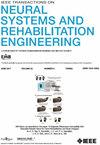Statistical Multiscore Functional Atlas Creation for Image-Guided Deep Brain Stimulation
IF 4.8
2区 医学
Q2 ENGINEERING, BIOMEDICAL
IEEE Transactions on Neural Systems and Rehabilitation Engineering
Pub Date : 2025-02-14
DOI:10.1109/TNSRE.2025.3542395
引用次数: 0
Abstract
Deep brain stimulation is increasingly performed for patients who suffer from drug-resistant movement disorders. It still remains challenging to determine the optimal electrode contact location to obtain the optimal surgical outcome and simultaneously minimize adverse effects. This paper proposes to construct a new statistical functional atlas to guide electrode contact targeting during deep brain stimulation. The construction of the atlas consists of four main steps: 1) multimodal image segmentation and registration, 2) activation volume modeling, 3) computing and combining multiple functional scores, and 4) generation of multiscore functional atlas. Based on these steps, the statistical functional atlas is created by integrating anatomical information analysis with multiple clinical scores that postoperatively characterize stimulation efficacy (e.g., motor symptom) and adverse effect. We evaluated the created atlas on 40 subthalamic nucleus stimulated parkinsonian patient datasets. The experimental results show that the reproducibility of the created statistical functional atlas was more than 75% in the cross validation. In addition, the motor, neuropsychological, and health scores can be reproduced up to 77%, 82%, and 78%. Compared to the actually implanted electrode position, the atlas predicted and the manually planned electrode position errors were 2.89 mm and 2.38 mm, respectively. The constructed multiscore atlas provides an automatic and accurate electrode targeting strategy that potentially outperforms manually planned approaches.图像引导深部脑刺激的统计多分功能图谱创建
脑深部电刺激越来越多地用于耐药运动障碍患者。确定最佳的电极接触位置以获得最佳的手术效果,同时最小化不良反应仍然是一个挑战。本文提出构建一种新的统计功能图谱,用于指导脑深部电刺激过程中电极接触定位。地图集的构建主要包括4个步骤:1)多模态图像分割与配准,2)激活体建模,3)计算并组合多个功能分数,4)生成多分数功能地图集。在这些步骤的基础上,通过将解剖学信息分析与多种临床评分相结合,创建统计功能图谱,这些评分可以在术后描述刺激效果(如运动症状)和不良反应。我们在40个丘脑下核刺激帕金森患者数据集上评估了创建的图谱。实验结果表明,所建立的统计功能图谱在交叉验证中可重复性达75%以上。此外,运动、神经心理和健康得分的重现率分别为77%、82%和78%。与实际植入的电极位置相比,图谱预测和人工规划的电极位置误差分别为2.89 mm和2.38 mm。构建的多分数图谱提供了一个自动和准确的电极定位策略,潜在地优于手动计划的方法。
本文章由计算机程序翻译,如有差异,请以英文原文为准。
求助全文
约1分钟内获得全文
求助全文
来源期刊
CiteScore
8.60
自引率
8.20%
发文量
479
审稿时长
6-12 weeks
期刊介绍:
Rehabilitative and neural aspects of biomedical engineering, including functional electrical stimulation, acoustic dynamics, human performance measurement and analysis, nerve stimulation, electromyography, motor control and stimulation; and hardware and software applications for rehabilitation engineering and assistive devices.

 求助内容:
求助内容: 应助结果提醒方式:
应助结果提醒方式:


